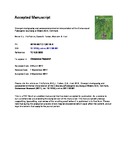Dinocyst stratigraphy and palaeoenvironmental interpretation of the Cretaceous/Paleogene boundary at Stevns Klint, Denmark
| dc.contributor.author | FitzPatrick, M | |
| dc.contributor.author | Forber, DA | |
| dc.contributor.author | Hart, Malcolm | |
| dc.date.accessioned | 2018-01-09T12:43:46Z | |
| dc.date.issued | 2017-09-23 | |
| dc.identifier.issn | 0195-6671 | |
| dc.identifier.issn | 1095-998X | |
| dc.identifier.uri | http://hdl.handle.net/10026.1/10515 | |
| dc.description.abstract |
A re-examination of the uppermost Maastrichtian chalks and an expanded section of the Fish Clay (Fiskeler Member) undertaken at Stevns Klint, Denmark, one of the classic outcrops of the Cretaceous/Paleogene boundary, has identified diverse and abundant dinoflagellate cyst assemblages, which are compared with earlier dinoflagellate cyst (dinocyst) studies. The uppermost part of the white coccolith chalk (Sigerslev Member) of the uppermost Maastrichtian is placed in the Palynodinium grallator Zone. The overlying ‘Grey Chalk’ (Højerup Member) represents a shallower-water marine succession that is characterised by a series of dune-like structures. The last common occurrence of P. grallator is within the Højerup Member, confirming the Danian age for the Fish Clay (Fiskeler Member) and a latest Maastrichtian age for the P. grallator Zone. Within the Fiskeler Member, Damassadinium californicum (previously known as Danea californica), a key biostratigraphical marker, is only intermittently present, while the distributions of Senoniasphaera inornata and Xenicodinium reticulatum provide useful biostratigraphic control. The well-preserved dinocysts of the Fiskeler Member are replaced by reduced assemblages in the Cerithium Limestone Member with only pollen grains recorded. | |
| dc.format.extent | 408-421 | |
| dc.language | en | |
| dc.language.iso | en | |
| dc.publisher | Elsevier | |
| dc.subject | K/Pg boundary | |
| dc.subject | Dinoflagellate cysts | |
| dc.subject | Biostratigraphy | |
| dc.subject | Fiskeler member | |
| dc.title | Dinocyst stratigraphy and palaeoenvironmental interpretation of the Cretaceous/Paleogene boundary at Stevns Klint, Denmark | |
| dc.type | journal-article | |
| dc.type | Journal Article | |
| plymouth.author-url | https://www.webofscience.com/api/gateway?GWVersion=2&SrcApp=PARTNER_APP&SrcAuth=LinksAMR&KeyUT=WOS:000432767200028&DestLinkType=FullRecord&DestApp=ALL_WOS&UsrCustomerID=11bb513d99f797142bcfeffcc58ea008 | |
| plymouth.volume | 87 | |
| plymouth.publication-status | Published | |
| plymouth.journal | Cretaceous Research | |
| dc.identifier.doi | 10.1016/j.cretres.2017.09.001 | |
| plymouth.organisational-group | /Plymouth | |
| plymouth.organisational-group | /Plymouth/Faculty of Science and Engineering | |
| plymouth.organisational-group | /Plymouth/Faculty of Science and Engineering/School of Geography, Earth and Environmental Sciences | |
| plymouth.organisational-group | /Plymouth/Users by role | |
| plymouth.organisational-group | /Plymouth/Users by role/Academics | |
| dcterms.dateAccepted | 2017-09-02 | |
| dc.rights.embargodate | 2018-9-23 | |
| dc.identifier.eissn | 1095-998X | |
| dc.rights.embargoperiod | Not known | |
| rioxxterms.versionofrecord | 10.1016/j.cretres.2017.09.001 | |
| rioxxterms.licenseref.uri | http://www.rioxx.net/licenses/all-rights-reserved | |
| rioxxterms.licenseref.startdate | 2017-09-23 | |
| rioxxterms.type | Journal Article/Review |


